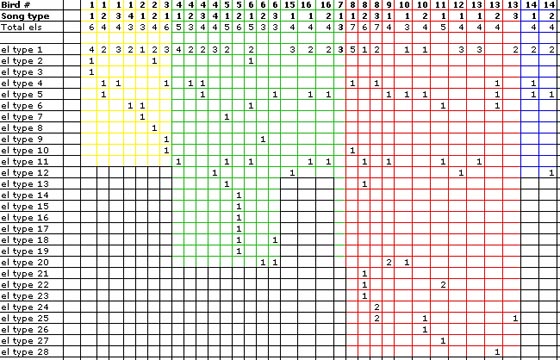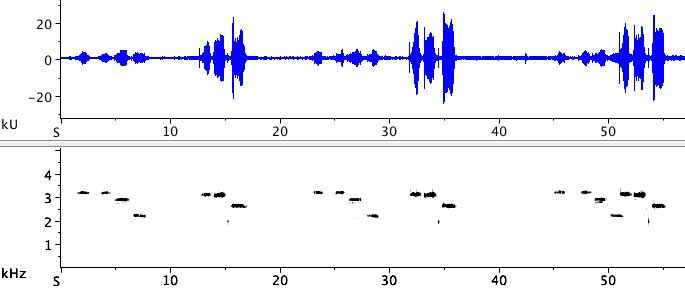
© Larry Master
Dominican Republican
Rufous-throated Solitaire
See element types
Rufous-throated Solitaire (Myadestes genibarbis) Songs in the Dominican Republic
BACK
From March 20 to March 24, 2004 I recorded Rufous-throated Solitaires in the Baoruca mountains of the Dominican Republic near the Haiti border. Jason and Andrea Townsend took me to the area, Pueblo Viejo, where they were studying Bicknell's Thrush and todies. I recorded in three areas, the Aguacate road to Perdernales, Pueblo Viejo, and Palo de Agua (3 kilometers west of Pueblo Viejo). In the following, the birds and song types are identified by names of the form RTSDRx.y, denoting bird x, song type y. Songs consist of 3 to 7 elements, which are the distinct sounds separated by small amounts, significantly less than the intersong interval. In the spectrogram for RTSDR16.02, there are 4 elements of three types. The first 2 elements are of type 1: flat whistles, the third is type 5, the fourth, type 11. An element type is determined by its structure, not its tone.
 |
|
© Larry Master |
Typical song of a Dominican Republic Rufous-throated Solitaire, RTSDR16.02. Click spectrogram to hear song. See element types |
Songs are delivered by repeating songs of one type for a period of time, not multiple types alternated. A single song type was recorded being repeated for as long as ten minutes, once every 5 to 25 seconds. This is different from Black-faced and Andean Solitaires, Myadestes melanops and ralloides, which sing in packages, alternating among two to seven types at a stretch.
Sixteen Rufous-throated Solitaires were recorded. Birds sang between 1 and 4 song types. Many birds were recorded over several days. Since single song types are sung for long stretches, it is always possible that not enough songs were recorded to observe full repertoires. This is surely the case for some birds, but some were recorded enough to give credence to having recorded the whole repertoire or close to it. RTSDR04 is an example of such a bird, having been recorded each day from March 21 to March 24.
A total of 33 song types were recorded; they contained a total of 139 elements, 3 to 7 elements per song, for an an average of 4.2 elements per song. There were 28 element types, the most frequently used being the flat whistle, e. g., the first two in RTSDR16.02. Flat whistles accounted for 42% of the element types in songs.
Elements in different songs can be similar, but song types themselves are mostly dissimilar. No examples of matched countersinging, i.e., two birds singing songs of the same type back and forth, were observed. Countersinging with songs that were somewhat similar was observed; see below.
Click below for song and element type spectrograms and songs. Click on any spectrogram to hear the sound represented. In the song types for RTSDR01 each element is annotated with its element type number which can be clicked to see the element in more detail and hear it alone. The table of element types per song type below can be used to find the element types in subsequent song types.
Song Type Structure
The following depicts the occurence of elements in the song types. Each column, third and subsequent, contains data on one song type of one bird. For example, the column with 8 in row 1 (Bird #) and 3 in row 2 (Song Type) has the data for RTSDR08.03. The rows labeled el type 1 through el type 28 contain the number of occurences of element types 1 through 28 in the song types corresponding `to the columns.
 |
Birds 1 to 3 (yellow) are from the Aguacate road; birds 4 to 6, and birds 15 and 16 (green) are from the Pueblo Viejo study area, birds 7 to 14 (red) are from the Palo de Agua study area, 3 kilometers west of Pueblo Viejo, and bird 14 (blue) is from between Pueblo Viejo and Palo de Agua.
This shows that element types are shared among song types from the three areas surveyed: 15 element types (54%) are shared; 5 occur in all three areas. The average percentage of shared elements within an area is 33%, and 21% between areas.
Countersinging
I observed no cases of matched countersinging. In a few instances birds countersang with songs that were close in details. Birds RTSDR09 and RTSDR10 in the Palo de Agua area sang back and forth with two songs that were very similar though one had 4 elements and the other had 3. Here is spectrogram and wave form of a part of the interchange. The wave form shows the different volumes, indicating that bird 9 is further away than bird 10.
 |
RTSDR09 and RTSDR10 countersinging with RTSDR09.01 and RTSDR10.01
Another case of countersinging with similar songs
RTSDR16.02 answered by an unknown bird